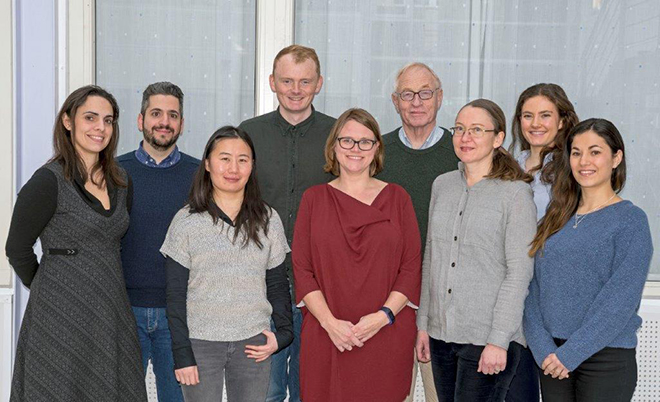About the group
Maja Elstad started the human integrative cardiovascular control lab (CIRCON) in 2018, and we are an interdisciplinary group with background from:
- physiology
- clinical medicine
- applied mathematics
- physics
- computer science
We combine non-invasive human experiments with advanced mathematical analytical tools.
We publish within the fields:
- cardiovascular oscillations
- mathematical model simulation
- anaesthesiology and intensive care medicine
- cardiology
- skin circulation/temperature regulation.
CIRCON has developed from the pioneering work by Professor Lars Walløe and Professor Marianne Thoresen.
Research goals
Our main research focus is human cardiovascular control. We consist of an interdisciplinary team in our study physiological control mechanisms. We study central haemodynamics both in healthy humans and in patients suffering conditions such as hypovolemic shock, autoimmune vascular diseases.
We are fascinated by the oscillations present in all cardiovascular variables and puzzled by their oscillatory patterns. We are involved in several projects shortly described below.
Cardiorespiratory interactions
We investigate the possible buffering effect of respiratory sinus arrhythmia on the systemic blood flow and arterial blood pressure. We have also studied the effect of respiratory circulation pump during hypovolemia.
Cerebral blood flow control
We have investigated the cerebral blood flow in awake healthy human subjects during central hypovolemia, mechanical ventilation and head-down tilt protocols. We study cerebral blood flow with changing cardiorespiratory interactions, and we are in search an optimal relationship between spontaneous breathing and hypovolemia to prevent drop in cerebral blood flow.
Endothelial and autonomic function
We have investigated the microcirculation and autonomic function. We further study the effect of oscillators in the human circulation at different ambient temperatures. In this project, we also investigate the interactions between cardiorespiratory and skin blood flow oscillations.
Selected Projects
2018-2020: Cerebral perfusion and oscillations in arterial blood pressure. Personal PhD student fellowship to Nathalie Holme funded by IMB.
2014-2019: A hierarchy of oscillators? Interaction between temperature regulation, respiratory sinus arrhythmia and blood pressure variability. Young Research talent grant from the Research Council of Norway.
2010-2014: Cardiac stroke volume and its contribution to the circulation: Interaction of mechanical and nervous factors affecting the heart. Personal postdoctoral grant to Maja Elstad, funded by the Research Council of Norway.
Selected publications
1.Internal Carotid Artery Blood Flow Response to Anesthesia, Pneumoperitoneum, and Head-up Tilt during Laparoscopic Cholecystectomy. Skytioti M, Elstad M, Søvik S. Anesthesiology. 2019 Sep;131(3):512-520. doi: 10.1097/ALN.0000000000002838. PMID: 31261258
2.Dynamic cerebral autoregulation is preserved during isometric handgrip and head-down tilt in healthy volunteers. Skytioti M, Søvik S, Elstad M. Physiol Rep. 2018 Mar;6(6):e13656. doi: 10.14814/phy2.13656. PMID: 29595918 Free PMC Article
3.Cardiorespiratory interactions in humans and animals: rhythms for life. Elstad M, O'Callaghan EL, Smith AJ, Ben-Tal A, Ramchandra R. Am J Physiol Heart Circ Physiol. 2018 Jul 1;315(1):H6-H17. doi: 10.1152/ajpheart.00701.2017. Epub 2018 Mar 9. Review. PMID: 29522373 Free Article
4. Respiratory pump maintains cardiac stroke volume during hypovolemia in young, healthy volunteers. Skytioti M, Søvik S, Elstad M. J Appl Physiol (1985). 2018 May 1;124(5):1319-1325. doi: 10.1152/japplphysiol.01009.2017. Epub 2018 Mar 1. PMID: 29494288 Free Article
5. Respiration-related cerebral blood flow variability increases during control-mode non-invasive ventilation in normovolemia and hypovolemia. Skytioti M, Søvik S, Elstad M.Eur J Appl Physiol. 2017 Nov;117(11):2237-2249. doi: 10.1007/s00421-017-3711-0. Epub 2017 Sep 12. PMID: 28900720
6.Oscillatory pattern of acral skin blood flow within thermoneutral zone in healthy humans. Elstad M, Zilakos I, Bergersen TK. Physiol Meas. 2017 May;38(5):848-859. doi: 10.1088/1361-6579/aa5fee. Epub 2017 Feb 10. PMID: 28186494
7.Cold-induced sympathetic tone modifies the impact of endothelium-dependent vasodilation in the finger pulp. Bergersen TK, Skytioti M, Elstad M. Auton Neurosci. 2017 Mar;203:97-102. doi: 10.1016/j.autneu.2016.11.004. Epub 2016 Nov 30. PMID: 27932205
8. Internal carotid artery blood flow in healthy awake subjects is reduced by simulated hypovolemia and noninvasive mechanical ventilation. Skytioti M, Søvik S, Elstad M. Physiol Rep. 2016 Oct;4(19). pii: e12969. PMID: 27702883 Free PMC Article
9. Cardiac stroke volume variability measured non-invasively by three methods for detection of central hypovolemia in healthy humans. Holme NL, Rein EB, Elstad M. Eur J Appl Physiol. 2016 Dec;116(11-12):2187-2196. Epub 2016 Sep 10. PMID: 27614883
